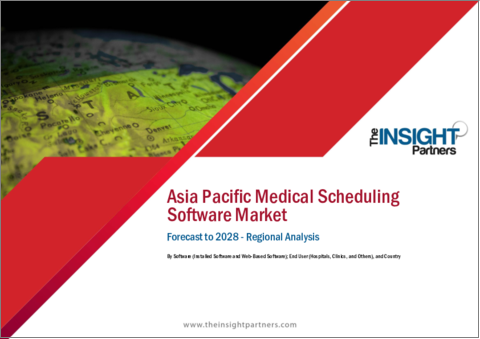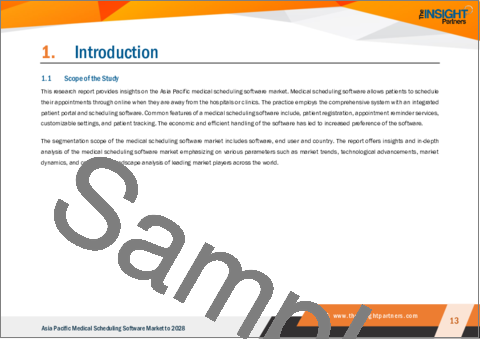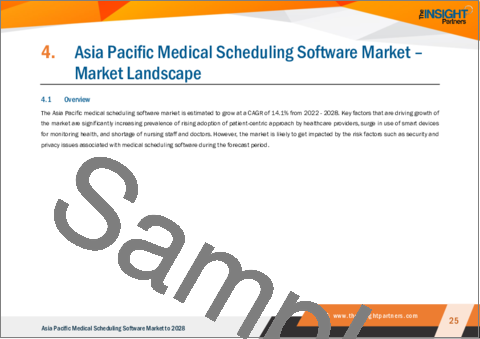|
|
市場調査レポート
商品コード
1402714
アジア太平洋の医療スケジューリングソフトウェア市場の2028年までの予測:地域別分析- ソフトウェア別、エンドユーザー別Asia Pacific Medical Scheduling Software Market Forecast to 2028 - Regional Analysis - by Software (Installed Software and Web-Based Software) and End User (Hospitals, Clinics, and Others) |
||||||
|
|||||||
| アジア太平洋の医療スケジューリングソフトウェア市場の2028年までの予測:地域別分析- ソフトウェア別、エンドユーザー別 |
|
出版日: 2023年11月23日
発行: The Insight Partners
ページ情報: 英文 88 Pages
納期: 即納可能
|
全表示
- 概要
- 図表
- 目次
アジア太平洋の医療スケジューリングソフトウェア市場は、2022年の9,675万米ドルから2028年には2億1,311万米ドルに成長すると予測されています。2022年から2028年までのCAGRは14.1%と推定されます。
モバイル医療技術の普及がアジア太平洋の医療スケジューリングソフトウェア市場を牽引
モバイル技術の進歩は、健康への関心の高まりと相まって、世界中でmヘルスサービス(MHS)の成長に拍車をかけています。モバイルおよびワイヤレス技術は、ヘルスケアの提供方法を変える可能性を秘めています。モバイル技術とアプリケーションの急速な進歩、モバイルヘルスを既存のeヘルスサービスに統合する新たな機会の増加、モバイル携帯電話ネットワークの継続的な拡大が、mヘルスソリューションの普及を支える主な要因のひとつです。ワイヤレス通信の普及は、ケアの質と患者の健康増進に役立つだけでなく、単に処方薬の不備の問題への対処を支援することで、毎年膨大な不必要な医療費を節約することにもなります。糖尿病のケアと予防に役立つmヘルスアプリの可能性は、mヘルスアプリ制作者にとって最も重要な領域の1つになると思われます。これは、患者が入院という形で発生する追加コストを削減するのに役立ちます。また、改善されたインターネット接続性に加えて、特に発展途上国におけるインターネットコストの減少は、mヘルスアプリケーションの採用を後押しする主な要因です。
アジア太平洋の医療スケジューリングソフトウェア市場概要
アジア太平洋の医療スケジューリングソフトウェア市場は、中国、日本、インド、韓国、オーストラリア、その他アジア太平洋に区分されます。中国は2021年に最大の市場シェアを占め、インドは同市場で大きな成長率を示すと予想されます。これらの国々における市場成長の背景には、疾病の有病率の増加、老人人口の増加、政府のさまざまな取り組みがあります。また、市場参入企業による事業拡大や製品投入戦略が、同地域の医療スケジューリングソフトウェア市場の成長に寄与すると期待されています。
中国の医療スケジューリングソフトウェア市場は、ヘルスケア分野におけるデジタル技術の採用が増加していることから、今後数年間で大きな成長が見込まれます。また、中国政府は、ヘルスケアサービスの質とアクセシビリティを向上させるため、デジタルヘルスソリューションの利用を推進しています。ヘルシー・チャイナ2030」計画の下、中国は今後数年間、医療技術革新のさらなる進展に向けた大規模な投資を計画しています。この支出は、技術の進歩とヘルスケアシステムの改善を通じて、中国国内における健康の公平性を確保することを目的としています。
アジア太平洋の医療スケジューリングソフトウェア市場の収益と2028年までの予測(金額)
アジア太平洋の医療スケジューリングソフトウェア市場のセグメンテーション
アジア太平洋の医療スケジューリングソフトウェア市場は、ソフトウェア、エンドユーザー、国別に区分されます。
ソフトウェア別に見ると、アジア太平洋の医療スケジューリングソフトウェア市場は、ウェブベースソフトウェアとインストール型ソフトウェアに区分されます。2022年のアジア太平洋の医療スケジューリングソフトウェア市場は、ウェブベースのソフトウェアが大きなシェアを占めています。
エンドユーザー別に見ると、アジア太平洋の医療スケジューリングソフトウェア市場は、病院、診療所、その他のエンドユーザーに区分されます。2022年のアジア太平洋医療スケジューリングソフトウェア市場シェアは、病院セグメントが最大でした。
国別に見ると、アジア太平洋の医療スケジューリングソフトウェア市場は、中国、日本、インド、オーストラリア、韓国、その他アジア太平洋に区分されます。2022年のアジア太平洋の医療スケジューリングソフトウェア市場シェアは中国が独占。
MedicalMine Inc、Q-nomy Inc、TerminApp GmbH、WellSkyは、アジア太平洋の医療スケジューリングソフトウェア市場で事業を展開している大手企業です。
目次
第1章 イントロダクション
第2章 アジア太平洋の医療スケジューリングソフトウェア市場:要点
第3章 調査手法
- 調査範囲
- 2次調査
- 1次調査
第4章 アジア太平洋の医療スケジューリングソフトウェア市場:市場情勢
- PEST分析
- アジア太平洋のPEST分析
- 専門家の見解
第5章 アジア太平洋の医療スケジューリングソフトウェア市場:主な市場力学
- 市場促進要因
- ヘルスケアプロバイダーによる患者中心アプローチの採用増加
- 健康モニタリング用スマートデバイスの利用急増
- 看護スタッフと医師の不足
- 主な市場抑制要因
- セキュリティとプライバシーの問題
- 主な市場機会
- モノのインターネットに関する知識の増加
- 今後の動向
- モバイルヘルス技術の受け入れ拡大
- 影響分析
第6章 アジア太平洋の医療スケジューリングソフトウェア市場:アジア太平洋の分析
- アジア太平洋の医療スケジューリングソフトウェア市場収益と予測分析
第7章 アジア太平洋の医療スケジューリングソフトウェア市場-2028年までの収益と予測:ソフトウェア別
- ウェブベースソフトウェア
- インストール型ソフトウェア
第8章 アジア太平洋の医療スケジューリングソフトウェア市場分析と2028年までの予測:エンドユーザー別
- 病院
- 診療所
- その他
第9章 アジア太平洋の医療スケジューリングソフトウェア市場-収益と2028年までの予測:国別分析
第10章 アジア太平洋の医療スケジューリングソフトウェア市場:業界情勢
- 市場参入企業の成長戦略
- 有機的展開
- 無機的展開
第11章 企業プロファイル
- Q-nomy Inc
- WellSky
- TerminApp GmbH
- MedicalMine Inc
第12章 付録
List Of Tables
- Table 1. China Medical Scheduling Software Market, by Software - Revenue and Forecast to 2028 (US$ Million)
- Table 2. China Medical Scheduling Software Market, by End User - Revenue and Forecast to 2028 (US$ Million)
- Table 3. Japan Medical Scheduling Software Market, by Software - Revenue and Forecast to 2028 (US$ Million)
- Table 4. Japan Medical Scheduling Software Market, by End User - Revenue and Forecast to 2028 (US$ Million)
- Table 5. India Medical Scheduling Software Market, by Software - Revenue and Forecast to 2028 (US$ Million)
- Table 6. India Medical Scheduling Software Market, by End User - Revenue and Forecast to 2028 (US$ Million)
- Table 7. South Korea Medical Scheduling Software Market, by Software - Revenue and Forecast to 2028 (US$ Million)
- Table 8. South Korea Medical Scheduling Software Market, by End User - Revenue and Forecast to 2028 (US$ Million)
- Table 9. Australia Medical Scheduling Software Market, by Software - Revenue and Forecast to 2028 (US$ Million)
- Table 10. Australia Medical Scheduling Software Market, by End User - Revenue and Forecast to 2028 (US$ Million)
- Table 11. Rest of Asia Pacific Medical Scheduling Software Market, by Software - Revenue and Forecast to 2028 (US$ Million)
- Table 12. Rest of Asia Pacific Medical Scheduling Software Market, by End User - Revenue and Forecast to 2028 (US$ Million)
- Table 13. Organic Developments Done by Companies
- Table 14. Inorganic Developments Done by Companies
- Table 15. Glossary of Terms
List Of Figures
- Figure 1. Asia Pacific Medical Scheduling Software Market Segmentation
- Figure 2. Asia Pacific Medical Scheduling Software Market Segmentation, By Region
- Figure 3. Asia Pacific Medical Scheduling Software Market Overview
- Figure 4. Web-Based Software Held Largest Share of Software Segment in Asia Pacific Medical Scheduling Software Market
- Figure 5. China Region Is Expected to Show Remarkable Growth During the Forecast Period
- Figure 6. Asia Pacific: PEST Analysis
- Figure 7. Asia Pacific Experts' Opinion
- Figure 8. Asia Pacific Medical Scheduling Software Market Impact Analysis of Driver and Restraints
- Figure 9. Asia Pacific Medical Scheduling Software Market - Revenue Forecast and Analysis - 2020- 2028
- Figure 10. Asia Pacific Medical Scheduling Software Market Revenue Share, by Software 2021 & 2028 (%)
- Figure 11. Web-Based Software: Asia Pacific Medical Scheduling Software Market - Revenue and Forecast to 2028 (US$ Million)
- Figure 12. Installed Software: Asia Pacific Medical Scheduling Software Market - Revenue and Forecast to 2028 (US$ Million)
- Figure 13. Asia Pacific Medical Scheduling Software Market, by End User 2021 & 2028 (%)
- Figure 14. Hospitals: Asia Pacific Medical Scheduling Software Market - Revenue and Forecast to 2028 (US$ Million)
- Figure 15. Clinics: Asia Pacific Medical Scheduling Software Market - Revenue and Forecast to 2028 (US$ Million)
- Figure 16. Others: Asia Pacific Medical Scheduling Software Market - Revenue and Forecast to 2028 (US$ Million)
- Figure 17. Asia Pacific: Medical Scheduling Software Market, by Key Country - Revenue (2021) (US$ Million)
- Figure 18. China: Medical Scheduling Software Market - Revenue and Forecast to 2028 (US$ Million)
- Figure 19. Japan: Medical Scheduling Software Market - Revenue and Forecast to 2028 (US$ Million)
- Figure 20. India: Medical Scheduling Software Market - Revenue and Forecast to 2028 (US$ Million)
- Figure 21. South Korea: Medical Scheduling Software Market - Revenue and Forecast to 2028 (US$ Million)
- Figure 22. Australia: Medical Scheduling Software Market - Revenue and Forecast to 2028 (US$ Million)
- Figure 23. Rest of Asia Pacific: Medical Scheduling Software Market - Revenue and Forecast to 2028 (US$ Million)
- Figure 24. Growth Strategies Done by the Companies in the Market, (%)
The Asia Pacific medical scheduling software market is expected to grow from US$ 96.75 million in 2022 to US$ 213.11 million by 2028. It is estimated to grow at a CAGR of 14.1% from 2022 to 2028.
Increasing Acceptance of Mobile Health Technology fuels Asia Pacific Medical Scheduling Software Market
Advancements in mobile technology, coupled with growing health concerns, are fueling the growth of mHealth services (MHS) across the world. Mobile and wireless technologies hold the potential to change the way healthcare is delivered. Rapid advancements in mobile technologies and applications, an increase in new opportunities for integrating mobile health into existing eHealth services, and ongoing expansion of mobile cellular network coverage are among the major factors supporting the proliferation of mHealth solutions. The proliferation of wireless communication would not only help enhance the quality of care and the health of patients but also save huge unnecessary healthcare costs every year by simply assisting in addressing the issue of poor prescription drugs. The applications of mHealth are likely to expand in the coming years. the potential of mHealth apps to help in diabetes care and prevention will be one of the most important domains for mHealth app producers. This helps patients in cutting down additional costs incurred in the form of hospital stays. Also, in addition to the improved internet connectivity, decreasing internet costs, particularly in developing countries, are the major factors boosting the adoption of mHealth applications.
Asia Pacific Medical Scheduling Software Market Overview
The Asia Pacific, medical scheduling software market is segmented into China, Japan, India, South Korea, Australia, and the Rest of Asia Pacific. China held the largest market share in 2021, and India is expected to exhibit a significant growth rate in the market. The market growth in these countries is attributed to the increasing prevalence of diseases, the rising geriatric population, and various government initiatives. Moreover, expansion and product launch strategies implemented by market players are expected to contribute to the growth of the medical scheduling software market in the region.
The market for medical scheduling software in China is expected to witness significant growth in the coming years due to the increasing adoption of digital technologies in the healthcare sector. The Chinese government is also promoting the use of digital health solutions to improve the quality and accessibility of healthcare services. Under the Healthy China 2030 plan, China plans to invest significantly in advancing its healthcare technology innovation further in the coming years. This expenditure is intended to ensure health equity within China through technological advancement and improvements to the healthcare system.
Asia Pacific Medical Scheduling Software Market Revenue and Forecast to 2028 (US$ Million)
Asia Pacific Medical Scheduling Software Market Segmentation
The Asia Pacific medical scheduling software market is segmented into software, end user, and country.
Based on software, the Asia Pacific medical scheduling software market is segmented into web-based software and installed software. The web-based software held a larger Asia Pacific medical scheduling software market share in 2022.
Based on end user, the Asia Pacific medical scheduling software market is segmented into hospitals, clinics, and other end users. The hospitals segment held the largest Asia Pacific medical scheduling software market share in 2022.
Based on country, the Asia Pacific medical scheduling software market is segmented into China, Japan, India, Australia, South Korea and the Rest of Asia Pacific. China dominated the Asia Pacific medical scheduling software market share in 2022.
MedicalMine Inc, Q-nomy Inc, TerminApp GmbH, and WellSky are some of the leading companies operating in the Asia Pacific medical scheduling software market in the region.
Reasons to Buy:
- Save and reduce time carrying out entry-level research by identifying the growth, size, leading players, and segments in the Asia Pacific medical scheduling software market.
- Highlights key business priorities in order to assist companies to realign their business strategies
- The key findings and recommendations highlight crucial progressive industry trends in the Asia Pacific medical scheduling software market, thereby allowing players across the value chain to develop effective long-term strategies
- Develop/modify business expansion plans by using substantial growth offering developed and emerging markets
- Scrutinize in-depth Asia Pacific market trends and outlook coupled with the factors driving the medical scheduling software market, as well as those hindering it
- Enhance the decision-making process by understanding the strategies that underpin commercial interest with respect to client products, segmentation, pricing, and distribution
Table Of Contents
1. Introduction
- 1.1 Scope of the Study
- 1.2 The Insight Partners Research Report Guidance
- 1.3 Market Segmentation
- 1.3.1 Asia Pacific Medical Scheduling Software Market - By Software
- 1.3.2 Asia Pacific Medical Scheduling Software Market - By End User
- 1.3.3 Asia Pacific Medical Scheduling Software Market - By Country
2. Asia Pacific Medical Scheduling Software Market - Key Takeaways
3. Research Methodology
- 3.1 Coverage
- 3.2 Secondary Research
- 3.3 Primary Research
4. Asia Pacific Medical Scheduling Software Market - Market Landscape
- 4.1 Overview
- 4.2 PEST Analysis
- 4.2.1 Asia Pacific - PEST Analysis
- 4.3 Expert Opinion
5. Asia Pacific Medical Scheduling Software Market - Key Market Dynamics
- 5.1 Market Drivers
- 5.1.1 Rising Adoption of Patient-Centric Approach by Healthcare Providers
- 5.1.2 Surge in Use of Smart Devices for Monitoring Health
- 5.1.3 Shortage of Nursing Staff and Doctors
- 5.2 Key Market Restraints
- 5.2.1 Security and Privacy Issues
- 5.3 Key Market Opportunities
- 5.3.1 Increasing Knowledge About the Internet of Things
- 5.4 Future Trend
- 5.4.1 Increasing Acceptance of Mobile Health Technology
- 5.5 Impact analysis
6. Asia Pacific Medical Scheduling Software Market- Asia Pacific Analysis
- 6.1 Asia Pacific Medical Scheduling Software Market Revenue Forecast and Analysis
7. Asia Pacific Medical Scheduling Software Market - Revenue and Forecast to 2028 - by Software
- 7.1 Overview
- 7.2 Asia Pacific Medical Scheduling Software Market Revenue Share, by Software 2021 & 2028 (%)
- 7.3 Web-Based Software
- 7.3.1 Overview
- 7.3.2 Web-Based Software: Asia Pacific Medical Scheduling Software Market - Revenue and Forecast to 2028 (US$ Million)
- 7.4 Installed Software
- 7.4.1 Overview
- 7.4.2 Installed Software: Asia Pacific Medical Scheduling Software Market - Revenue and Forecast to 2028 (US$ Million)
8. Asia Pacific Medical Scheduling Software Market Analysis and Forecasts to 2028 - by End User
- 8.1 Overview
- 8.2 Asia Pacific Medical Scheduling Software Market, by End User 2021 & 2028 (%)
- 8.3 Hospitals
- 8.3.1 Overview
- 8.3.2 Hospitals: Asia Pacific Medical Scheduling Software Market - Revenue and Forecast to 2028 (US$ Million)
- 8.4 Clinics
- 8.4.1 Overview
- 8.4.2 Clinics: Asia Pacific Medical Scheduling Software Market - Revenue and Forecast to 2028 (US$ Million)
- 8.5 Others
- 8.5.1 Overview
- 8.5.2 Others: Asia Pacific Medical Scheduling Software Market - Revenue and Forecast to 2028 (US$ Million)
9. Asia Pacific Medical Scheduling Software Market - Revenue and Forecast to 2028 - Country Analysis
- 9.1 Asia Pacific: Medical Scheduling Software Market
- 9.1.1 Overview
- 9.1.2 Asia Pacific: Medical Scheduling Software Market, by Country, 2021 & 2028 (%)
- 9.1.2.1 China: Medical Scheduling Software Market - Revenue and Forecast to 2028 (US$ Million)
- 9.1.2.1.1 Overview
- 9.1.2.1.2 China: Medical Scheduling Software Market - Revenue and Forecast to 2028 (US$ Million)
- 9.1.2.1.3 China: Medical Scheduling Software Market, by Software, 2019-2028 (US$ Million)
- 9.1.2.1.4 China Medical Scheduling Software Market, by End User, 2019-2028 (US$ Million)
- 9.1.2.2 Japan: Medical Scheduling Software Market - Revenue and Forecast to 2028 (US$ Million)
- 9.1.2.2.1 Overview
- 9.1.2.2.2 Japan: Medical Scheduling Software Market - Revenue and Forecast to 2028 (US$ Million)
- 9.1.2.2.3 Japan: Medical Scheduling Software Market, by Software, 2019-2028 (US$ Million)
- 9.1.2.2.4 Japan: Medical Scheduling Software Market, by End User, 2019-2028 (US$ Million)
- 9.1.2.3 India: Medical Scheduling Software Market - Revenue and Forecast to 2028 (US$ Million)
- 9.1.2.3.1 Overview
- 9.1.2.3.2 India: Medical Scheduling Software Market - Revenue and Forecast to 2028 (US$ Million)
- 9.1.2.3.3 India: Medical Scheduling Software Market, by Software, 2019-2028 (US$ Million)
- 9.1.2.3.4 India: Medical Scheduling Software Market, by End User, 2019-2028 (US$ Million)
- 9.1.2.4 South Korea: Medical Scheduling Software Market - Revenue and Forecast to 2028 (US$ Million)
- 9.1.2.4.1 Overview
- 9.1.2.4.2 South Korea: Medical Scheduling Software Market - Revenue and Forecast to 2028 (US$ Million)
- 9.1.2.4.3 South Korea: Medical Scheduling Software Market, by Software, 2019-2028 (US$ Million)
- 9.1.2.4.4 South Korea: Medical Scheduling Software Market, by End User, 2019-2028 (US$ Million)
- 9.1.2.5 Australia: Medical Scheduling Software Market - Revenue and Forecast to 2028 (US$ Million)
- 9.1.2.5.1 Overview
- 9.1.2.5.2 Australia: Medical Scheduling Software Market - Revenue and Forecast to 2028 (US$ Million)
- 9.1.2.5.3 Australia: Medical Scheduling Software Market, by Software, 2019-2028 (US$ Million)
- 9.1.2.5.4 Australia: Medical Scheduling Software Market, by End User, 2019-2028 (US$ Million)
- 9.1.2.6 Rest of Asia Pacific: Medical Scheduling Software Market - Revenue and Forecast to 2028 (US$ Million)
- 9.1.2.6.1 Overview
- 9.1.2.6.2 Rest of Asia Pacific: Medical Scheduling Software Market - Revenue and Forecast to 2028 (US$ Million)
- 9.1.2.6.3 Rest of Asia Pacific: Medical Scheduling Software Market, by Software, 2019-2028 (US$ Million)
- 9.1.2.6.4 Rest of Asia Pacific: Medical Scheduling Software Market, by End User, 2019-2028 (US$ Million)
- 9.1.2.1 China: Medical Scheduling Software Market - Revenue and Forecast to 2028 (US$ Million)
10. Asia Pacific Medical Scheduling Software Market - Industry Landscape
- 10.1 Overview
- 10.2 Growth Strategies Done by the Companies in the Market, (%)
- 10.3 Organic Developments
- 10.3.1 Overview
- 10.4 Inorganic Developments
- 10.4.1 Overview
11. Company Profiles
- 11.1 Q-nomy Inc
- 11.1.1 Key Facts
- 11.1.2 Business Description
- 11.1.3 Products and Services
- 11.1.4 Financial Overview
- 11.1.5 SWOT Analysis
- 11.1.6 Key Developments
- 11.2 WellSky
- 11.2.1 Key Facts
- 11.2.2 Business Description
- 11.2.3 Products and Services
- 11.2.4 Financial Overview
- 11.2.5 SWOT Analysis
- 11.2.6 Key Developments
- 11.3 TerminApp GmbH
- 11.3.1 Key Facts
- 11.3.2 Business Description
- 11.3.3 Products and Services
- 11.3.4 Financial Overview
- 11.3.5 SWOT Analysis
- 11.3.6 Key Developments
- 11.4 MedicalMine Inc
- 11.4.1 Key Facts
- 11.4.2 Business Description
- 11.4.3 Products and Services
- 11.4.4 Financial Overview
- 11.4.5 SWOT Analysis
- 11.4.6 Key Developments
12. Appendix
- 12.1 About The Insight Partners
- 12.2 Glossary of Terms






